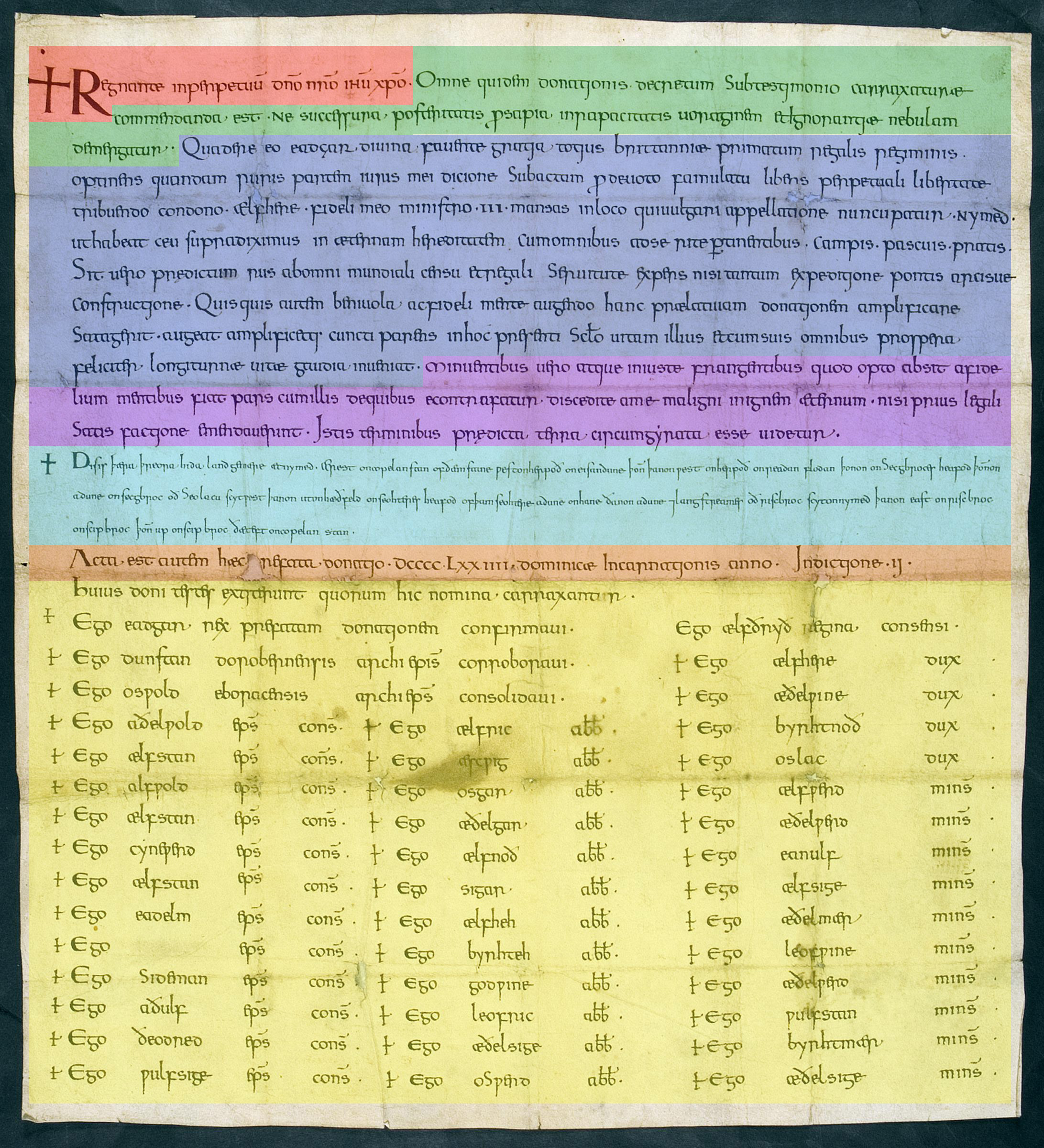
Section One:
Our Lord Jesus Christ reigneth for ever.
Section Two:
It is advisable that every deed of gift should be made under the testimony of writing, lest the succession of posterity be swallowed in the whirlpool of rapine and the clouds of ignorance.
Section Three:
Therefore I, Edgar, having by divine grace obtained the pre-eminence of royal rule over all Britain, being willing to endow with perpetual freedom a certain part of the country under my jurisdiction, do, in reward of his devoted service, grant unto Ælfhere, my faithful minister, three plots of ground in the place which is called in common parlance Nymed, that he may hold it, as we have above said, in perpetual inheritance, with all fields, woods, and meadows thereunto of right appertaining. Moreover, the aforesaid land is to be free of all secular tribute and royal service, excepting only going to the wars, and the building of bridges or castles. Whosoever therefore, moved by a benevolent and sincere disposition, shall trouble himself in amplifying this aforesaid grant, may the Parent of all increase and amplify his life in this present world, and may he and all his family happily experience the unclouded joys of that everlasting one to come.
Section Four:
But may they who shall diminish or unjustly violate the same, which God forbid should enter into the minds of the faithful, make part with those of whom, on the other hand, it is pronounced, ‘Depart from me, ye wicked, into everlasting fire,’ unless they shall have made lawful satisfaction beforehand.
Section Five:
This said land appears to be enclosed about by these bounds.
This is the landmere of the three hydes at Nymed – First, to Copelanstan ; from that stone westwards on to the high road at Eisandune; then therefrom westward to the high road at Red Flood; therefrom to Sedgbrook’s head; therefrom down Sedgbrook to where the stream strikes west; therefrom out on Heathfield to the ditch-head; from the ditch down on Hane; therefrom adown along stream to where Kushbrook strikes on Nymed; therefrom eastward on Eushbrook to Shipbrook ; then up Shipbrook, and so back to Copelanstan.
Section Six:
Moreover, this aforesaid grant was made in the year of the Incarnation of our Lord, DCCCCLXXIIII. In the second Indiction. These are the witnesses of this grant, whose names are here written.
Section Seven:
Eadgar the King confirms his grant for life, Ælfthrythe the Queen agrees.
| Dunstan Archbishop of Canterbury. | |
| Oswold Archbishop of York, | |
| Athelwold Bishop of Winchester, | |
| Ælfstan Bishop of London, | Abbot Godwine, |
| Alfwold Bishop of Sherborne, | Abbot Leofric, |
| Ælfstan bishop of Ramsbury, | Abbot Æthelsige, |
| Cynewed bishop of Wells, | Abbot Oswerd, |
| Ælfstan bishop of Rochester, | |
| Ealdelm Bishop of Slesey, | Ælfhere, |
| Sideman bishop of Crediton, | Æthelwine, |
| Adulf bishop of Hereford, | Byrhtnoth, |
| Theodred bishop of Elmham, | Oslac, |
| Wulfaaige bishop of Cornwall, | Ælfwerd, |
| Æthelwerd, | |
| Abbot Ælfric, | Eanulf, |
| Abbot Æacwig, | Ælfsige, |
| Abbot Oagan, | Æthelmær, |
| Abbot Æthelgan, | Leofwine, |
| Abbot Ælfnoth, | Æthelwerd, |
| Abbot Sigan, | Wulfstan, |
| Abbot Ælfheh, | Byrhtmær, |
| Abbot Byrhteh, | Æthelsige. |
The structure of the charter can be explored in several ways.
- Students could be given the highlighted charter and asked to assign the correct labels from the mixed list below.
- Students could be given one section of the charter and asked to present on its purpose. This could be a short paragraph, a discussion and feedback to the class, or a more creative output such as a poster.
- Students could consider why the charter is laid out in this order and whether changing the order of the sections has any effect on the meaning or purpose of the document.
- As this is a formal structure repeated in most charters of this type, students could consider why a formal structure is useful for grants of land and how the document would have been used at the time of its creation.
- Students could attempt to write their own charter following this structure, granting a classroom table to a group of students or the seat next to them to their friend.
What’s in a charter?
‘Date’ – When the charter was written.
‘Sanction’ – any punishment for those who go against the rules.
‘Grant’ – the actual gift of land or powers being given and their rewards
‘Bounds’ – the specific area of land being gifted.
‘Witnesses’ – The names of those who approve the gift.
‘Proem’ – a statement on the shortness of life or a reason to be writing the charter
‘Invocation’ – calling on religion to show the charter has its blessing.
(For answer key – please see downloadable PDF)
